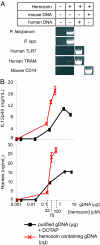Malaria hemozoin is immunologically inert but radically enhances innate responses by presenting malaria DNA to Toll-like receptor 9
- PMID: 17261807
- PMCID: PMC1794278
- DOI: 10.1073/pnas.0608745104
Malaria hemozoin is immunologically inert but radically enhances innate responses by presenting malaria DNA to Toll-like receptor 9
Abstract
Hemozoin (HZ) is an insoluble crystal formed in the food vacuole of malaria parasites. HZ has been reported to induce inflammation by directly engaging Toll-like receptor (TLR) 9, an endosomal receptor. "Synthetic" HZ (beta-hematin), typically generated from partially purified extracts of bovine hemin, is structurally identical to natural HZ. When HPLC-purified hemin was used to synthesize the crystal, beta-hematin had no inflammatory activity. In contrast, natural HZ from Plasmodium falciparum cultures was a potent TLR9 inducer. Natural HZ bound recombinant TLR9 ectodomain, but not TLR2. Both TLR9 stimulation and TLR9 binding of HZ were abolished by nuclease treatment. PCR analysis demonstrated that natural HZ is coated with malarial but not human DNA. Purified malarial DNA activated TLR9 but only when DNA was targeted directly to the endosome with a transfection reagent. Stimulatory quantities of natural HZ contain <1 microg of malarial DNA; its potency in activating immune responses was even greater than transfecting malarial DNA. Thus, although the malarial genome is extremely AT-rich, its DNA is highly proinflammatory, with the potential to induce cytokinemia and fever during disease. However, its activity depends on being bound to HZ, which we propose amplifies the biological responses to malaria DNA by targeting it to a TLR9(+) intracellular compartment.
Conflict of interest statement
The authors declare no conflict of interest.
Figures




Comment in
-
Malarial fever: hemozoin is involved but Toll-free.Proc Natl Acad Sci U S A. 2007 Feb 6;104(6):1743-4. doi: 10.1073/pnas.0610874104. Epub 2007 Feb 1. Proc Natl Acad Sci U S A. 2007. PMID: 17272492 Free PMC article. Review. No abstract available.
References
-
- Miller LH, Baruch DI, Marsh K, Doumbo OK. Nature. 2002;415:673–679. - PubMed
-
- Stevenson MM, Riley EM. Nat Rev Immunol. 2004;4:169–180. - PubMed
-
- Clark IA, Schofield L. Parasitol Today. 2000;16:451–454. - PubMed
-
- Miller LH, Good MF, Milon G. Science. 1994;264:1878–1883. - PubMed
-
- Francis SE, Sullivan DJ, Jr, Goldberg DE. Annu Rev Microbiol. 1997;51:97–123. - PubMed
Publication types
MeSH terms
Substances
Grants and funding
LinkOut - more resources
Full Text Sources
Other Literature Sources

